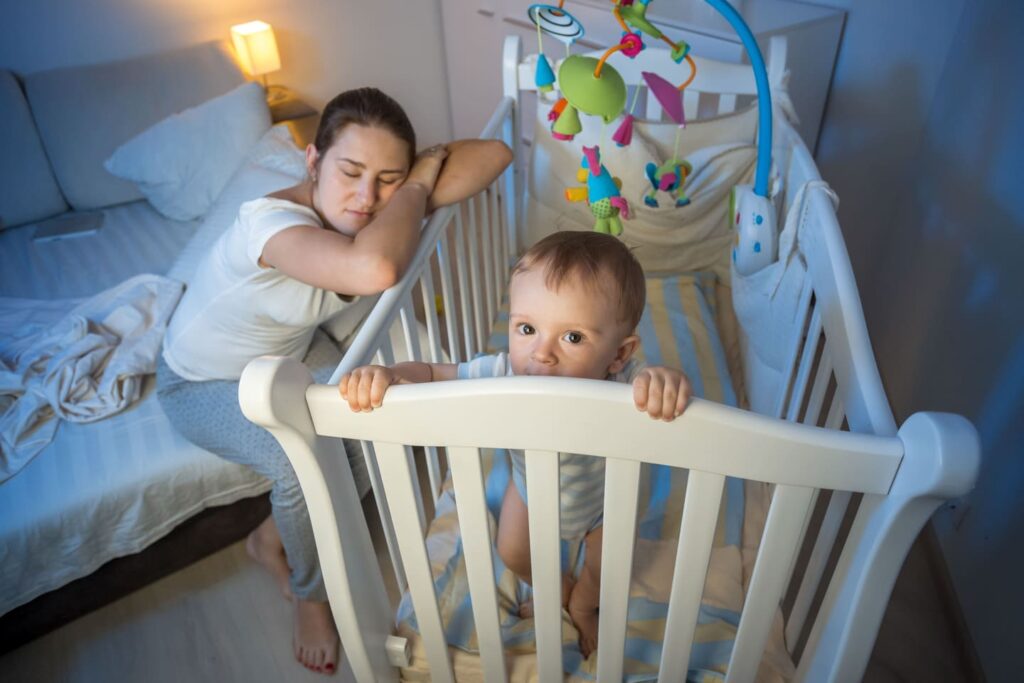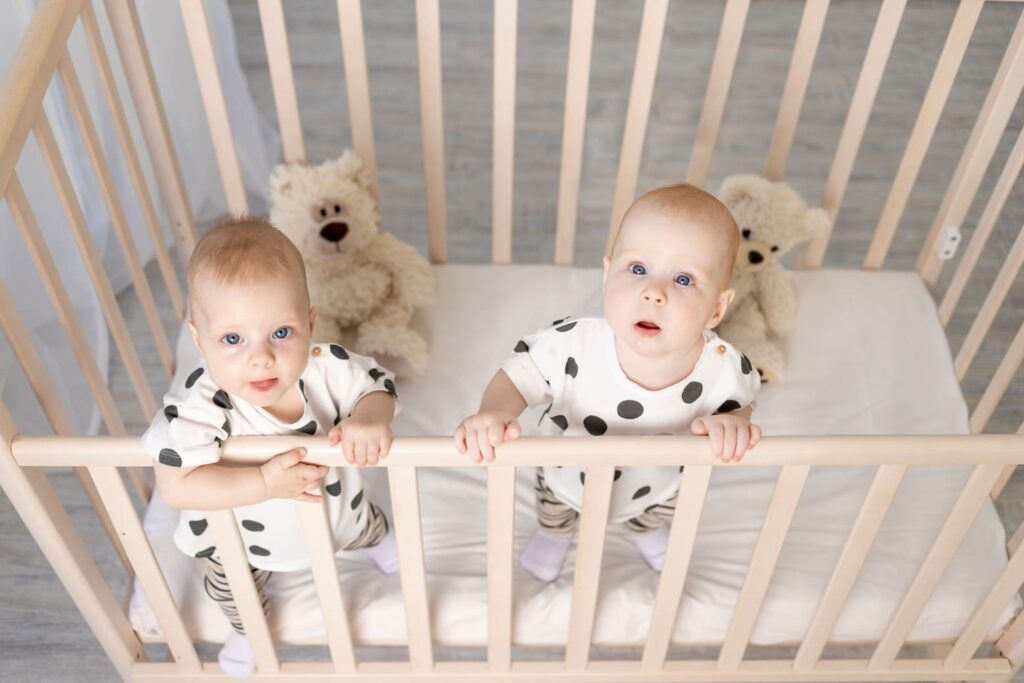Seeing your little ones pull themselves up to stand in their crib for the first time is an exciting milestone. Their beaming smile fills you with pride at this new achievement. However, the adventure-seeking standard can also raise safety concerns. Is crib standing an innocent step in their development? Or a dangerous maneuver needing intervention? This guide tackles all the dos and don’ts around Baby Standing in Crib.
When Do Your Baby Start Standing in Crib?
Most infants hit the standing milestone between 6 and 12 months old. They prop themselves upright by grabbing the crib rails and build coordination pulling up and balancing. Some eager babies surprise parents even earlier around 5 months. Late bloomers may not perfect the skill until 15-18 months, with the 9-month sleep regression being a prime standing trigger.
Regardless of exact age, crib standing signifies your little one’s growing strength, mobility, and curiosity to see the world from new heights. They gain confidence in their blossoming abilities. It’s important we encourage this self-assuredness while also guiding safe practices.
Top Safety Tips for Baby Standing in Crib
While hitting developmental milestones is wonderful, I’m sure you’ll agree taking precautions to avoid tumbles is vital too. Try these tips to balance crib safety and standing opportunities:
- Lower the mattress: Set it to the lowest level so falls from standing aren’t as far.
- Remove hazards: Take out bumpers, stuffies, and loose blankets that could be climb assists.
- Supervise play: Watch attempts closely, and help guide sitting back down.
- Add gripping assistance: Crib gyms with attached toys motivate pulling up.
- Try wearable sleeping aids: Products like the Zippity Zen Sack limit mobility.
- Transition when ready: Switch to a toddler bed or floor mattress if trying to escape.
The key is allowing standing while minimizing the risks. With attentive care and adaptations, both development and safety are possible.
Signs Your Standing Baby is Ready For a “Big Kid” Bed
When do you know your little stander has outgrown the containment of their crib? Here are 5 indicators to start planning that toddler bed transition:
- They stand steadily and easily: Up and down with good leg strength.
- Attempts to climb out increase: Frustration from the barricade builds.
- Needing the mattress lowered: Accommodate their court hearing.
- Increased curiosity: More glancing around, less sleeping.
- Over 12 months old: Guidelines suggest crib days are numbered.
Speak with your pediatrician about the ideal timing based on your baby’s physical and emotional maturity. While bittersweet, this prison break is a shining success story!

Why Is My Baby Suddenly Standing in Their Crib?
Wondering what prompts the upright position during sleepy times? Common motivations include:
Celebrating New Skills
Once they perfect pulling up, babies want to showcase their trick all day long – even when exhaustion should take over! Nap practice makes perfect in their minds.
Sleep Regressions Throw Things Off
Around 8-9 months, sleep cycles change. Standing passes the time when rest refuses to arrive. Teething and developmental leaps also perpetuate sleep disruptions.
Change of Environment
Traveling, moving, flipping their orientation, or even new pajamas can overstimulate babies. Standing self-soothes amid unfamiliar settings.
While each case is unique, identifying potential standing triggers can help remedy the root cause. Check for teething, modify sleep associations, adjust schedules, or update environments if restless standing persists.
Handling a Standing Baby Who Resists Sleep
It’s frustrating when your baby reaches the vertical vortex instead of dreamland. Try these techniques to encourage some zzz’s:
- Allow some standing: 5 minutes to meet their mobility need.
- Sit back down prompts: “Back to bed baby!” while patting the mattress.
- Add swaddle transitions: One arm out, then both over time.
- Implement sleep training: Gradual retreat or comforting check-ins.
- Set consistent bedtime routines: Bath, books, songs signal winding down.
- Room share nearby: Being close by soothes separation anxiety.
While initially counterintuitive, avoid rushing to rescue your stander. Let them figure out how to restfully return to a sleeping position. Mastering this skill builds developmental confidence. Stay patient – the standing too shall pass!

Causes For Concern Around Standing
When should you contact your pediatrician about baby standing in crib? Two scenarios that warrant assessment:
Early Standing Before 5 Months
If your baby hits this milestone very early, it may indicate hypermobility or loose joints. Physical therapy could improve stability and strength. Early standing can also mean they skip crawling – which foundationally hones coordination.
No Standing By 18 Months
On the flip side, if standing seems like an impossibility even well into toddlerhood, motor lags may be inhibiting progress. Underlying conditions could be impacting mobility too. Seek medical guidance to get your tardy stander back on track!
While the window is wide for “normal”, extremely premature or delayed standing deserves a deeper dive. Don’t hesitate to check in with experts.
Encouraging Safe Crib Standing Exploration
Standing in the crib is fascinating…until naptime arrives! Guide playtime practice with these engaging tips:
- Sing songs waving toys just out of reach to motivate pull-ups.
- Attach fun mirrors toward crib tops for selfie entertainment.
- Rotate crib gyms weekly to capture curiosity when standing.
- Share floor play standing too – variety builds better balance!
Anytime your baby shows interest in rising upright, cheer them on positively. Nurture these proud moments of blossoming independence. Before you know it, those first precarious steps won’t be far behind!
Conclusion: Patience and Perspective Through the Wobbles
Watching your totteeter upright for the first time is incredible. However, baby standing in crib double life testing your patience come sleep time also reveals their fiery tenacity. Try to embrace this strange juxtaposition. With attentive care taking safety measures, allow standing too. Master finding balance between protective worry and promoting development.
These topsy-turvy months won’t last forever, although it may feel never-ending in the thick of it. Take comfort from the fleeting newborn days that this standing phase too shall pass. Savor the snuggles after inevitable falls. With understanding and adaptations, both adventures and ample rest are possible. Applaud each rising stand, no matter how sleepy you may be!
FAQS – Baby standing in crib
What age do babies typically start standing in their crib?
Most babies start standing in their crib holding onto the sides between 6-12 months old. Some eager standers surprise parents even earlier around 5 months. Others don’t perfect standing until 15-18 months. But any time in this range is developmentally normal.
Is it dangerous to let my baby stand in their crib?
Standing in cribs is generally safe if you take some safety precautions – keeping the mattress lowered, removing hazards like loose bedding, ensuring the crib is structurally sound, and closely supervising play. Allowing standing promotes healthy development.
How can I get my baby to sit back down after standing in their crib?
To avoid frustration or unsafe toppling, teach them to intentionally sit first before allowing full standing freedom. Use sit-to-stand cues and games while awake. Be patient at nap time, avoid immediately rescuing. Offer gentle guidance but let them gain the confidence to return to sitting and laying positions.
My baby fell while standing in their crib – should I be concerned?
Some falls naturally happen as babies build coordination skills. Provide comfort if they cry and watch for any abnormal symptoms from injuries. Brief tumbles help babies learn to fall safely though, so it’s not necessarily concerning. But do mention any significant falls to your pediatrician.
What’s the best way to transition my standing baby out of the crib?
When your baby starts attempting to climb out of the crib consistently, it’s time to move to a toddler bed. Make it exciting and involve them in decorating their new “big kid space!” Safety proof the room and use toddler bed rails. Keep doors secured at bedtime too in this new phase!











